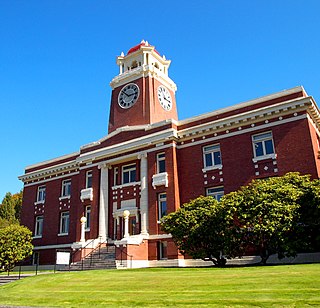
Clallam County is a county in the U.S. state of Washington. As of the 2020 census, the population was 77,155, with an estimated population of 77,805 in 2022. The county seat and largest city is Port Angeles; the county as a whole comprises the Port Angeles, WA Micropolitan Statistical Area. The name is a Klallam word for "the strong people". The county was formed on April 26, 1854. Located on the Olympic Peninsula, it is south from the Strait of Juan de Fuca, which forms the Canada–US border, as British Columbia's Vancouver Island is across the strait.

Sequim is a city in Clallam County, Washington, United States. It is located along the Dungeness River near the base of the Olympic Mountains. The 2020 census counted a population of 8,018, with an estimated population in 2021 of 8,241.
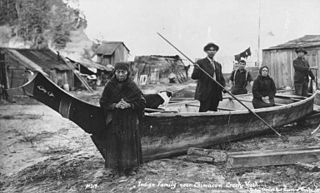
The Klallam are a Coast Salish people Indigenous to the northern Olympic Peninsula. The language of the Klallam is the Klallam language, a language closely related to the North Straits Salish languages. The Klallam are today citizens of four recognized bands: Three federally-recognized tribes in the United States and one band government in Canada. Two Klallam tribes, the Jamestown S'Klallam and Lower Elwha Klallam, live on the Olympic Peninsula, and one, the Port Gamble S'Klallam, on the Kitsap Peninsula in Washington state. In Canada, the Scia'new First Nation is based at Becher Bay on southern Vancouver Island in British Columbia.
The Jamestown S'Klallam Tribe is a federally recognized tribe of S'Klallam or Klallam Native Americans. They are on the northern Olympic Peninsula of Washington state in the northwestern United States.
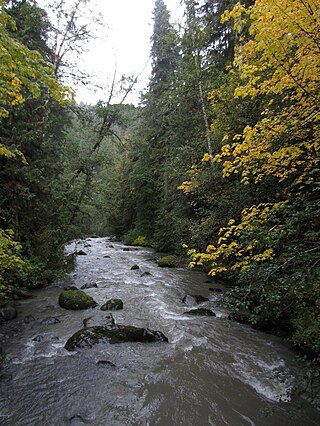
The Dungeness River is a 28-mile (45 km) long river located in the Olympic Peninsula in the U.S. state of Washington. It rises near Mount Constance in the Olympic Mountains within the Olympic National Park, flows through the Buckhorn Wilderness, passes by the town of Sequim, and empties into the Strait of Juan de Fuca at Dungeness Bay, behind the Dungeness Spit. One of its main tributaries is the Gray Wolf River. It is crossed by the Dungeness River Bridge.

Dungeness Spit is a sand spit jutting out approximately 5 miles (8 km) from the northern edge of the Olympic Peninsula in northeastern Clallam County, Washington into the Strait of Juan de Fuca. It is the longest natural sand spit in the United States. The spit is growing in length by about 15 feet (4.6 m) per year. The body of water it encloses is called Dungeness Bay.

The Dungeness crab makes up one of the most important seafood industries along the west coast of North America. Its typical range extends from Alaska's Aleutian Islands to Point Conception, near Santa Barbara, California. Dungeness typically grow 6–7 in (150–180 mm) at their widest point and inhabit eelgrass beds and sandy bottoms. Its common name comes from the Dungeness Spit in the Strait of Juan de Fuca, Washington state, United States, which shelters a shallow bay inhabited by the crabs.
Jamestown is an unincorporated community and census-designated place (CDP) in Clallam County, Washington, United States. The population was 361 at the 2010 census.

The SequimMuseum & Arts, located in downtown Sequim, Washington, is a free-admission local history museum. Founded in 1976, the museum is home to the Manis Mastodon tusks and bones which were found at an early human encampment located on the present day Manis Farm, famous as one of the first-known contact between humans with a mastodon 13,000 years ago.
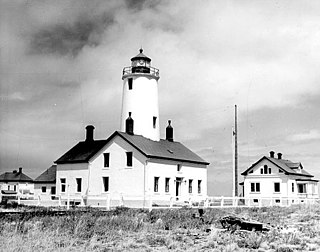
The New Dungeness Lighthouse is a functioning aid to navigation on the Strait of Juan de Fuca, located on the Dungeness Spit in the Dungeness National Wildlife Refuge near Sequim, Clallam County, in the U.S. state of Washington. It has been in continuous operation since 1857, although the current lighthouse tower is 26 feet (7.9 m) shorter than when first constructed.

Protection Island is an island located in the Strait of Juan de Fuca just north of Discovery Bay in northeastern Jefferson County, Washington, United States. The island has a land area of 379 acres (153 ha). It is a federally protected National Wildlife Refuge; boats are not permitted within 200 yards (180 m) for the safety and health of wildlife on and near the shores. There is only one individual still living on the island not associated with the government. Marty Bluewater has lifetime use of his inholding cabin on the island's southern bluffs. The island also houses a caretaker, a volunteer hired by the United States Fish and Wildlife Service, to watch over the island and take care of its many inhabitants. Boat trips from nearby Port Townsend, Washington provide ecotourism visits for viewing wildlife from the adjacent waters.
The Dungeness National Wildlife Refuge is located near the town of Sequim in Clallam County in the U.S. state of Washington, on the Strait of Juan de Fuca. The refuge is composed of 772.52 acres (312.63 ha) which include Dungeness Spit, Graveyard Spit, and portions of Dungeness Bay and Harbor. Dungeness Spit is one of the world's longest natural sand spits, 6.8 miles (10.9 km) long and very narrow. A lighthouse, the New Dungeness Light, built in 1857, is located near the end of the spit. Access to Dungeness Spit is through a Clallam County Park which has hiking trails, picnic areas, and a campground. On January 20, 1915, it was designated as a National Wildlife Refuge by President Woodrow Wilson. Dungeness is one of six refuges in the Washington Maritime National Wildlife Refuge Complex.
Dungeness is a headland in Kent, England.

The Dungeness School is a historical schoolhouse building located at 657 Towne Road in Dungeness, Washington. The idea for the school was formed in 1892 by the settlers of the Dungeness area. On May 10, 1892 a meeting was held in which settlers created a bond for land and a two-story school house. In August 1892, the Dungeness Beacon reported that the contract for construction was awarded to Hall and Duncan for $1,673. The school house opened on February 27, 1893. The school originally had 73 students from the ages of 5 to 20. The school had one teacher who lived on the second floor of the school. Classes were large and books and supplies not easy to get. School Board minutes of April 8, 1895, show a motion was passed to buy the school a bottle of ink.

Crab fisheries are fisheries which capture or farm crabs. True crabs make up 20% of all crustaceans caught and farmed worldwide, with about 1.4 million tonnes being consumed annually. The horse crab, Portunus trituberculatus, accounts for one quarter of that total. Other important species include flower crabs, snow crabs (Chionoecetes), blue crabs, edible or brown crabs, Dungeness crab, and mud crabs, each of which provides more than 20,000 tonnes annually.
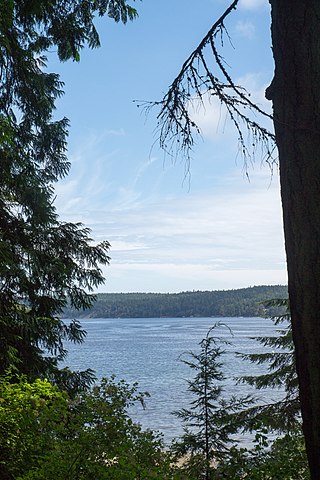
Sequim Bay State Park is a public recreation area covering 92 acres (37 ha) on the shore of Sequim Bay, on the Puget Sound side of the Olympic Peninsula in Clallam County, Washington. The state park sits within the Sequim rain shadow, has over 4,900 feet (1,500 m) of shoreline and offers picnicking, camping, hiking, boating, swimming, clam digging, crabbing, athletic fields, beachcombing, birdwatching, interpretive activities, and horseshoes.

George Washington Inn is a bed and breakfast inn located between Sequim and Port Angeles on the Olympic Peninsula in the U.S. state of Washington. It was built as a replica of Mount Vernon, the home of George Washington. The inn opened for business on February 16, 2008. Located near the Olympic National Park, the inn is on a ten-acre waterfront estate and lavender farm in the Sequim Valley at the foot of the Olympic Mountains. The Strait of Juan de Fuca stretches northward from the inn's 130 foot (40 m) high bluff to the city of Victoria, British Columbia and the San Juan Islands. The New Dungeness Light, the Discovery Island Light and the Race Rocks Light are all visible from the inn.
Fritz Cove is a bay on the northwestern coast of Douglas Island in the City and Borough of Juneau, Alaska, United States. Lying in Stephens Passage, it is 8 miles (13 km) northwest of the city of Juneau.

The Dungeness crab in the Puget Sound, Washington state is a non-genetically distinct population of Dungeness that has been experiencing severely declining populations in the south sound region since 2013. The cause of the decline is unknown, although it has been determined not to be due to overfishing. As crabbing seasons remain closed or severely limited throughout the south sound region, research is focused primarily on larvae in order to predict future population size and study genetics.

















